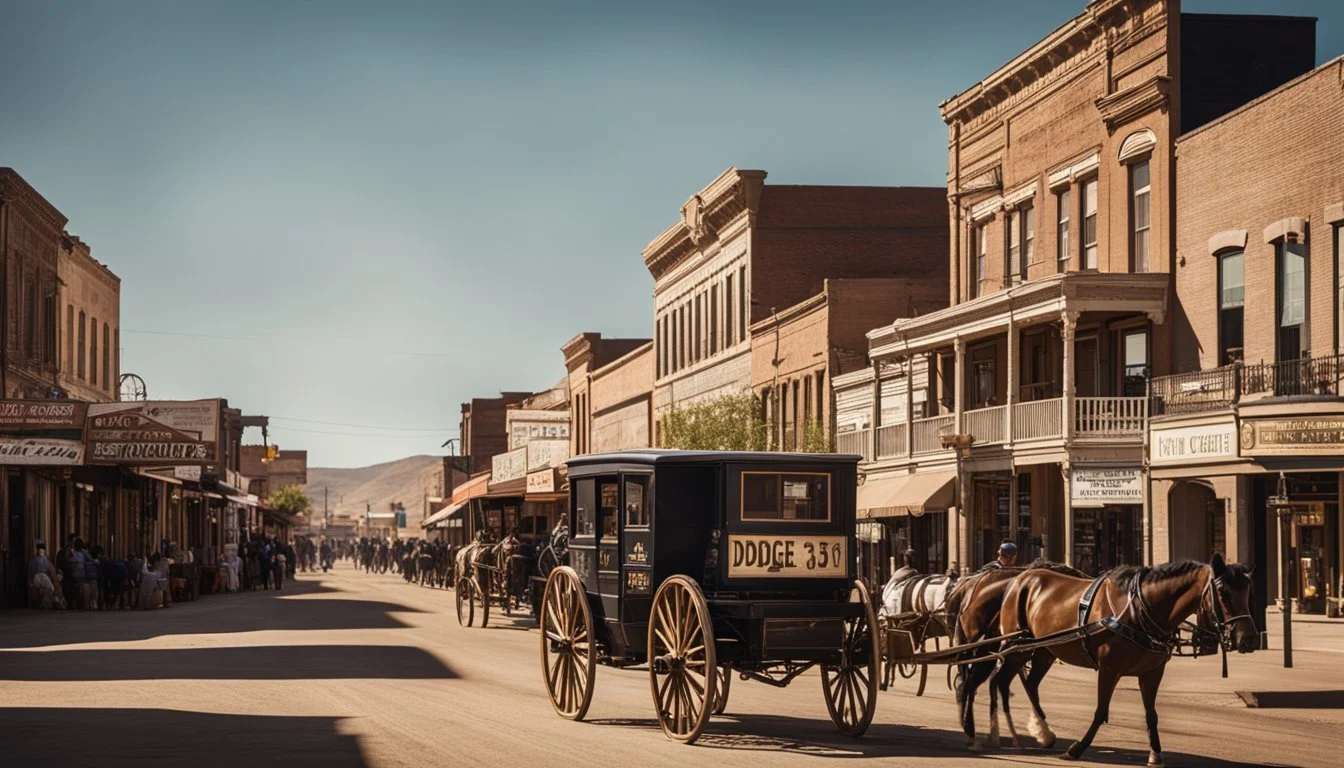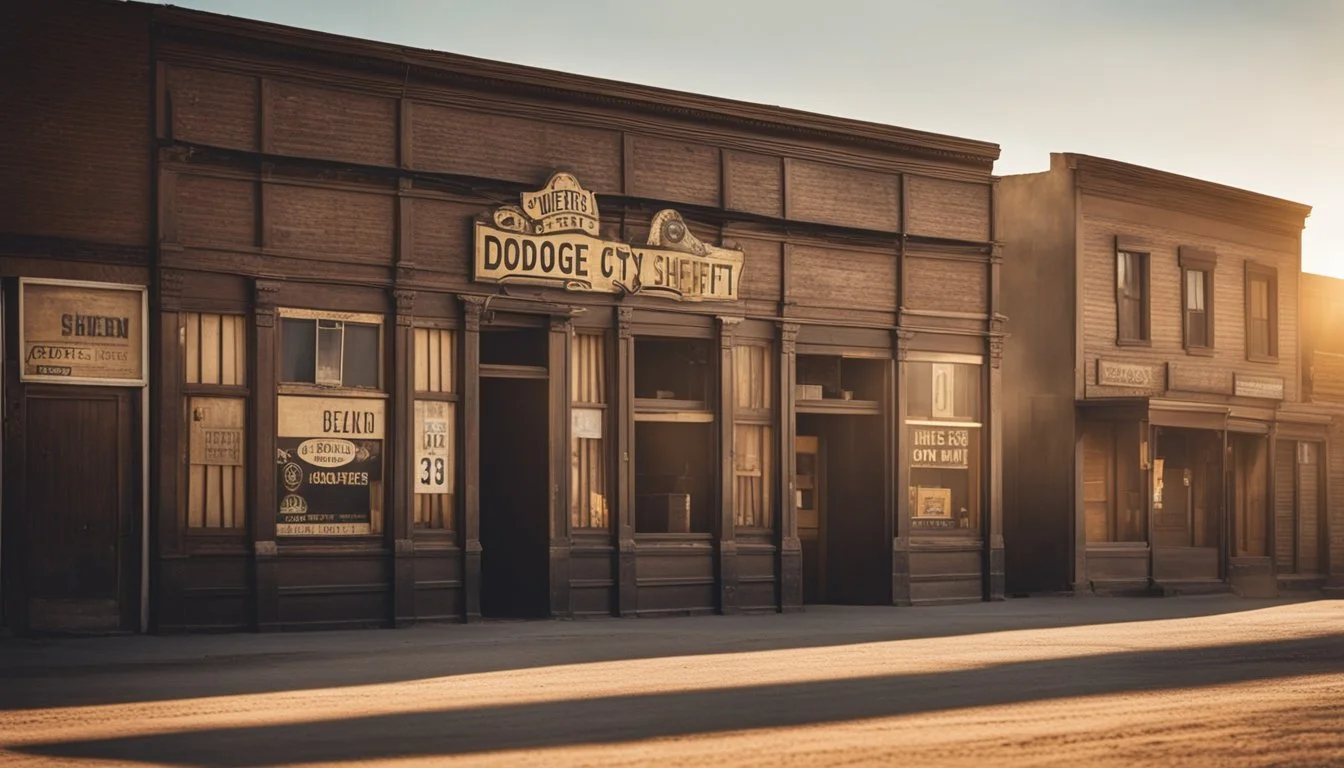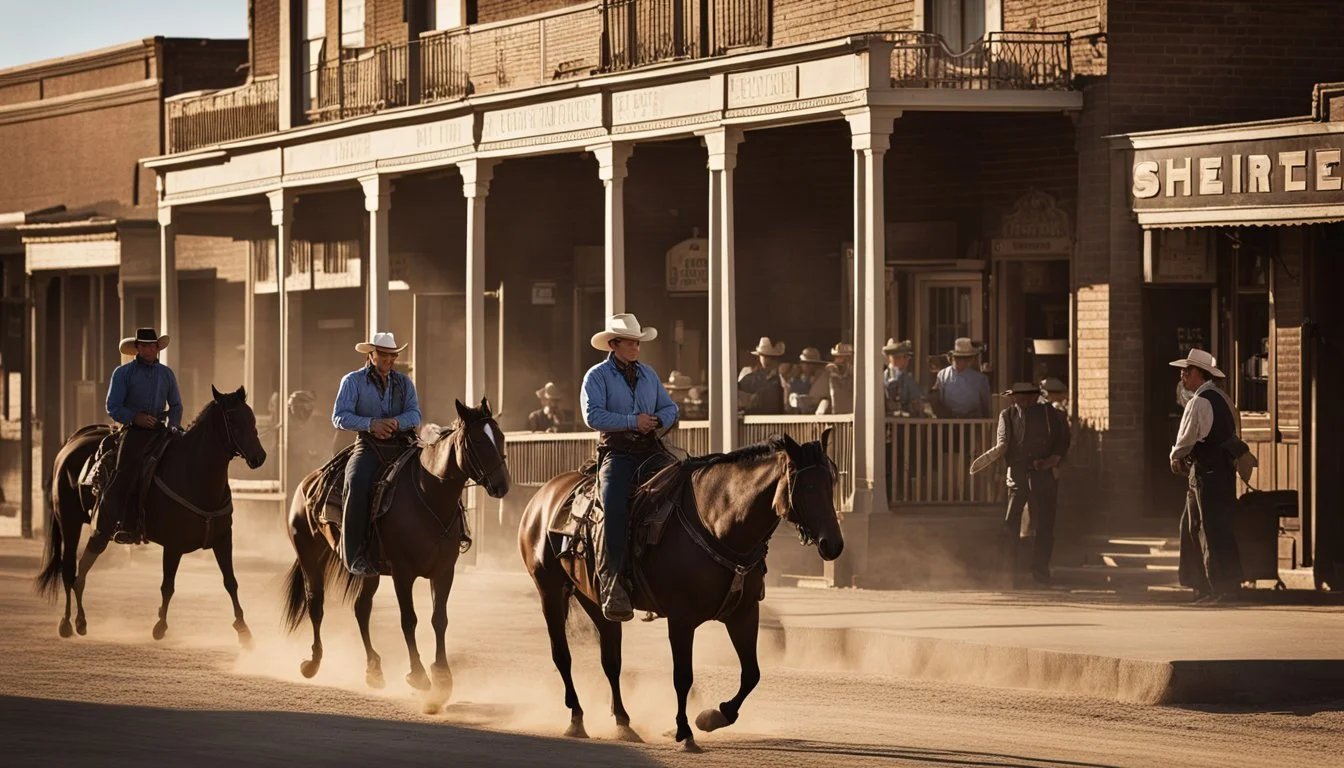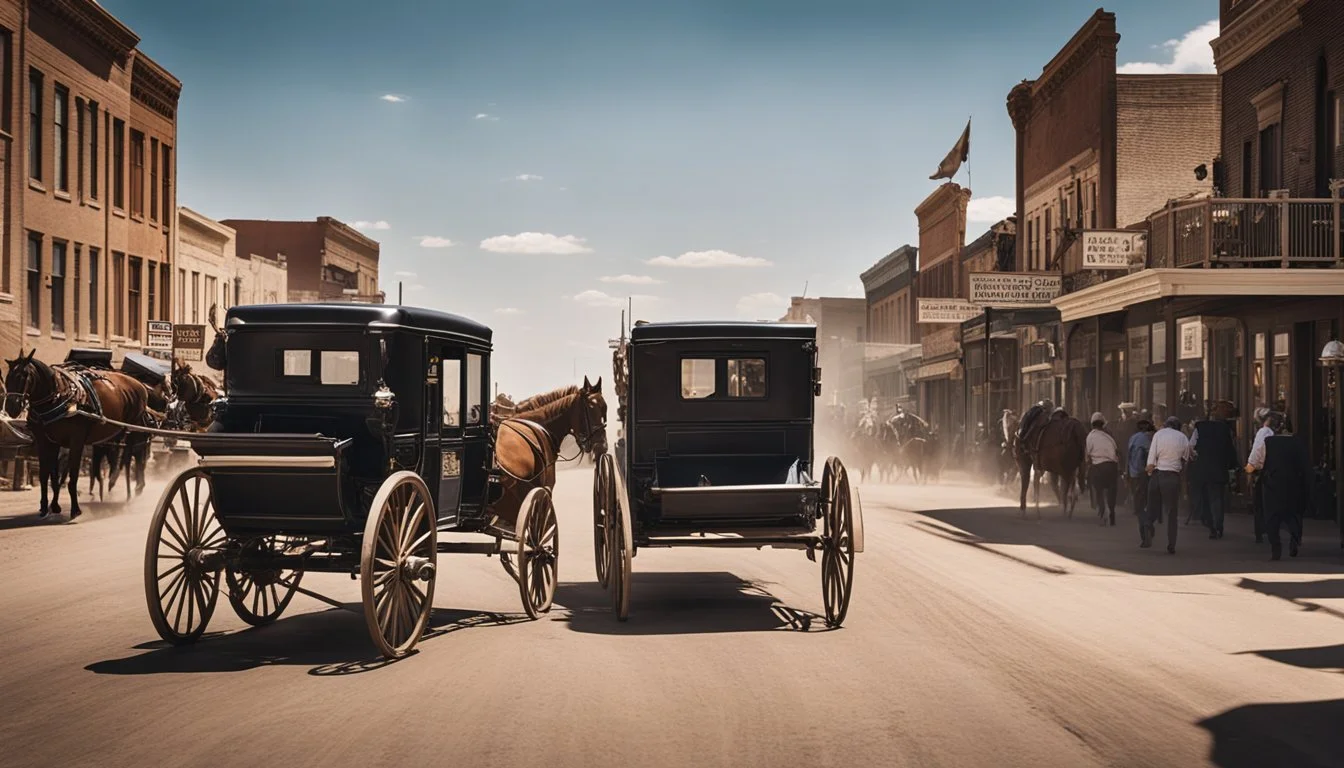4 Documentaries Showcasing James Masterson's Dodge City Career
Exploring the Wild West Lawman's Legacy
James Masterson played a significant role in shaping the law enforcement landscape of Dodge City, Kansas, during the late 19th century. As the brother of the famous Bat Masterson, James carved out his own legacy as a skilled lawman in one of the most notorious frontier towns of the Old West.
James Masterson's career as a Dodge City marshal spanned several years and involved numerous high-stakes encounters with outlaws and troublemakers. His experiences provide a fascinating glimpse into the challenges faced by law enforcement officers in a rapidly changing frontier society. These documentaries offer viewers an opportunity to explore the complex dynamics of Dodge City's social and political environment through the lens of James Masterson's career.
1) "The Man Who Tamed Dodge City" by John W. Smith (1952)
John W. Smith's documentary "The Man Who Tamed Dodge City" explores James Masterson's role in bringing law and order to the infamous Kansas town. The film showcases Masterson's efforts to curb violence and lawlessness during his tenure as a lawman.
Through interviews with locals and historical reenactments, Smith paints a vivid picture of Dodge City's tumultuous past. He highlights Masterson's strategic approach to enforcing the law and building relationships with the community.
The documentary delves into key moments of Masterson's career, including his confrontations with notorious outlaws and his implementation of new policing methods. It also examines the challenges he faced in maintaining order in a frontier town known for its saloons and gambling halls.
Smith's work provides valuable insights into the realities of law enforcement in the Old West. The film's use of archival photographs and documents adds authenticity to its portrayal of Masterson's time in Dodge City.
More information on "The Man Who Tamed Dodge City" (IMDB)
2) "James Masterson: Frontier Lawman" documentary (2012)
This documentary explores James Masterson's role as a lawman in Dodge City during the late 19th century. It depicts his tenure as a deputy marshal and later as city marshal, highlighting his contributions to maintaining order in the frontier town.
The film features reenactments of key events from Masterson's career, including his involvement in notable gunfights and arrests. Interviews with historians provide context on the challenges faced by law enforcement in the Wild West era.
"James Masterson: Frontier Lawman" examines the lawman's relationships with his more famous brother Bat Masterson and other prominent figures of the time. It offers insights into the dynamics of frontier justice and the realities of daily life in Dodge City.
The documentary uses archival photographs and newspaper clippings to illustrate Masterson's impact on the community. It also explores his legacy and how his actions helped shape the development of law enforcement in the American West.
More information on James Masterson
3) "Dodge City's Unsung Hero" series
"Dodge City's Unsung Hero" is a three-part documentary series released in 2020. It sheds light on James Masterson's contributions to law enforcement in Dodge City, Kansas during the late 19th century.
The first episode, "The Shadow of Wyatt," explores how James often operated in the background while his more famous brother Wyatt Earp garnered attention. It examines James's early days as a deputy marshal and his role in maintaining order.
Episode two, "Taming the Wild West," delves into Masterson's tactics for dealing with rowdy cowboys and outlaws. The documentary highlights his skill in defusing tense situations without resorting to violence.
The final installment, "Legacy of Law," discusses Masterson's lasting impact on Dodge City's transformation from a lawless frontier town to a more stable community. It features interviews with historians and descendants of Dodge City residents.
More information on the series
4) "Policing the Wild West: James Masterson's Legacy" (2022)
This documentary examines James Masterson's role in shaping law enforcement in Dodge City during the late 19th century. It delves into his strategies for maintaining order in a notoriously lawless frontier town.
The film highlights Masterson's tenure as a deputy marshal and later as city marshal. It explores his efforts to regulate saloons, gambling halls, and brothels that were rampant in Dodge City at the time.
Interviews with historians provide context on the challenges of policing in the Old West. They discuss Masterson's approach to dealing with outlaws and his reputation for being firm but fair in his duties.
Archival photographs and reenactments bring Masterson's era to life. The documentary also examines his relationships with other notable lawmen of the time, including his brother Bat Masterson and Wyatt Earp.
The film concludes by assessing James Masterson's lasting impact on Dodge City and his place in Wild West history.
More information on "Policing the Wild West: James Masterson's Legacy"
James Masterson: The Early Years
James Masterson's journey from Quebec to the American frontier shaped his path to becoming a lawman in Dodge City. His family background and initial experiences in the West laid the foundation for his later career in law enforcement.
Background and Family
James "Jim" Masterson was born on September 16, 1855, in Quebec, Canada. In 1871, the Masterson family relocated to Wichita, Kansas, seeking new opportunities in the American West. Jim was one of several brothers, including the famous Bat Masterson and Ed Masterson, who would all become involved in frontier law enforcement.
The Masterson brothers initially engaged in buffalo hunting, a common occupation for young men in the region during that era. This experience likely honed their shooting skills and familiarized them with the rugged lifestyle of the frontier.
Initial Involvement in Law Enforcement
Jim Masterson's entry into law enforcement followed his brother Ed's footsteps. After a brief stint as a saloonkeeper in Dodge City, Jim joined the local police force as an assistant marshal in 1878. This appointment came shortly after the tragic death of his brother Ed, who had been serving as the Dodge City Marshal.
Jim's early days as an assistant marshal involved working alongside notable figures like Wyatt Earp, who was also a Deputy Marshal at the time. On July 26, 1878, Jim and Wyatt faced a dangerous situation when a group of cowboys opened fire while riding through town at 3:30 a.m.
This incident showcased Jim's readiness to confront the lawlessness that often plagued frontier towns. His initial experiences in law enforcement set the stage for what would become the longest career among the Masterson brothers in Dodge City's police force.
Dodge City: The Heart of the Wild West
Dodge City emerged as an iconic frontier town in the late 19th century. Its reputation for lawlessness and adventure drew gunfighters, gamblers, and settlers alike, shaping its place in American history.
Historical Significance of Dodge City
Dodge City rose to prominence in the 1870s as a major stop on the Santa Fe Trail. The town's strategic location made it a crucial trading post and cattle shipping point. Cowboys drove massive herds of longhorns from Texas to the railhead in Dodge City.
The city's population swelled during cattle season. Saloons, dance halls, and brothels flourished, catering to cowboys flush with cash. This wild atmosphere earned Dodge City nicknames like "The Wickedest Little City in America" and "Sodom of the Plains."
Notable figures like Wyatt Earp, Bat Masterson, and Doc Holliday walked the streets of Dodge City. Their presence added to the town's legendary status in Wild West lore.
The Challenges of Maintaining Law and Order
Keeping peace in Dodge City proved difficult due to its transient population and rough reputation. Lawmen faced constant threats from drunken cowboys, professional gamblers, and outlaws.
The city established a "deadline" - an invisible boundary north of the railroad tracks. Carrying firearms beyond this line was prohibited, helping reduce violence in the business district.
Despite efforts to tame the town, gunfights and brawls remained common. Sheriffs and marshals like Wyatt Earp worked to enforce the law, often resorting to quick-draw tactics to subdue troublemakers.
Dodge City's economy relied on its wild reputation, creating tension between maintaining order and preserving the town's lucrative frontier image. This delicate balance shaped the city's development throughout the late 1800s.
Masterson's Role and Achievements
James Masterson served as Assistant Marshal in Dodge City during a pivotal period in the late 1870s. He played a crucial role in maintaining law and order in the bustling frontier town, working alongside other notable lawmen of the era.
Key Events and Incidents
James Masterson became Assistant Marshal in Dodge City in June 1878, following the tragic death of his brother Ed Masterson in the line of duty. His appointment came at a time when Dodge City was known for its rowdy reputation as a cow town.
Masterson quickly made his mark on the town's law enforcement efforts. He worked to curb violence and maintain order, particularly in the saloons and brothels that dotted the city. His presence helped deter criminal activity and reassure law-abiding citizens.
One notable incident involved Masterson's handling of a troublesome cowboy named George Hoy. Hoy had opened fire on the Comique Variety Hall, causing a disturbance. Masterson's swift response to this situation demonstrated his commitment to protecting the town's residents and businesses.
Collaboration with Other Famous Lawmen
James Masterson's tenure as Assistant Marshal coincided with the presence of other legendary lawmen in Dodge City. He worked under Marshal Charlie Bassett, who had replaced Ed Masterson after his death.
Notably, Wyatt Earp served as a Deputy Marshal during this time, along with his brother James Earp. This collaboration of skilled lawmen created a formidable team to tackle the challenges of maintaining order in the frontier town.
Masterson and his colleagues enforced the "dead line" in Dodge City, a boundary north of which firearms were prohibited. This policy aimed to reduce violence and create a safer environment for residents and visitors alike.
The partnership between Masterson and these renowned lawmen contributed significantly to Dodge City's gradual transformation from a wild frontier outpost to a more civilized community.
Legacy and Impact
James Masterson's tenure as a lawman in Dodge City left an enduring mark on the town's history and American frontier lore. His actions and experiences continue to captivate audiences and shape perceptions of the Old West.
Influence on Popular Culture
James Masterson's legacy lives on through various media portrayals. Books, films, and television series have featured him as a character, often alongside his more famous brother Bat Masterson. These depictions tend to emphasize his role in maintaining order in Dodge City during its wild days.
The Masterson brothers' exploits have inspired countless Western stories and characters. Their experiences have been dramatized and romanticized, contributing to the mythic image of the frontier lawman.
James' time as assistant marshal in Dodge City is frequently referenced in historical accounts of the American West. His collaboration with other legendary figures like Wyatt Earp adds to the intrigue surrounding his career.
Modern Interpretations and Debates
Historians continue to analyze James Masterson's contributions to law enforcement in the Old West. Some argue that his role has been overshadowed by his brothers' fame, particularly Bat's.
Recent scholarship has sought to provide a more nuanced view of James' career. Researchers examine primary sources to separate fact from fiction in popular narratives about his time in Dodge City.
Debates persist about the extent of James' influence on Dodge City's development. Some historians credit him with playing a crucial role in the town's transition from a lawless frontier outpost to a more stable community.
Modern interpretations often focus on the complexities of law enforcement in the Old West. James Masterson's experiences are used to illustrate the challenges faced by lawmen in frontier towns.







